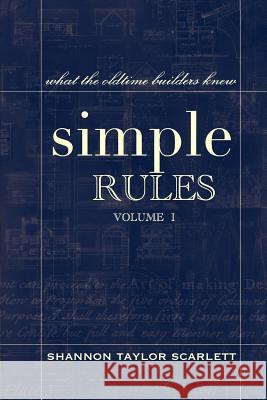Simple Rules: What the Oldtime Builders Knew » książka
Simple Rules: What the Oldtime Builders Knew
ISBN-13: 9781484152072 / Angielski / Miękka / 2013 / 126 str.
SIMPLE RULES What the Oldtime Builders Knew a new kind of builder handbook/ design guide Publisher's Weekly said: "This thoughtful and thought-provoking little gem outlines 25 crucial design principles that the author believes have been jeopardized as domestic architecture has become dominated by developers. Scarlett, who runs an architecture firm in Wellesley, Mass., aims to 'remind those in the building community that simple beauty and meaning... is still reproducible in new homes, and that many traditional building techniques are still applicable in today's economy, and within current construction practices.' In this, she succeeds terrifically. Most of this attractively illustrated book consists of quotations taken from original sources published from the 16th to early 20th centuries. These sources are building manuals such as Palladio's Four Books of Architecture (1570), which inspired many of America's greatest public and private buildings, as well as lesser-known volumes such as T.F. Hamlin's The Enjoyment of Architecture (1921). The rules are broken down by chapter and include 'Genius of the Place, ' 'Asymmetry, ' and 'Proportion.' Each includes quotations to explain the concept and several well-chosen illustrations to graphically demonstrate the idea. The annotated bibliography at the end is a bonus and provides direction for those who seek further elaboration. Anyone interested in architecture-professionals, students, home-improvers, renovators, home 'flippers, ' or anyone who regards suburbia with a critical eye-will enjoy this useful and well-written compilation." B&w illus. (BookLife) 9/19/2016 http: //www.publishersweekly.com/978-1-4841-5207-2 Inspired by long forgotten sources, the design content included here-timeless composition principles, elegant proportional systems, building techniques and formulas for making buildings more beautiful-is intended as a guide for the modern builder who cares about aesthetics and meaning as much or more than the bottom line. simple RULE 1 STRENGTH, UTILITY, AND BEAUTY "All architecture should possess strength, utility, and beauty." Marcus Vitruvius Pollio Strength arises from carrying down the foundations to a good solid bottom, and from making a proper choice of materials without parsimony. ] Utility arises from a judicious distribution of the parts, so that their purposes be duly answered, and that each has its proper situation. Beauty is produced by the pleasing appearance and good taste of the whole, and by the dimensions of all the parts being duly proportioned to each other. +parsimony: economy of means, cost-cutting Marcus Vitruvius Pollio De Architectura, Book STRENGTH, UTILITY, AND BEAUTY "As one principal figure should always stand out as the foremost, ...to which all subordinate purposes should contribute and lend their aid. " simple RULE 5 THREE DIMENSIONALITY "Always keep in mind the perspective appearance when designing the exterior of a detached building, and not merely the front elevation." Richard Brown, Architect "From every possible view a really good building must have balance..." Talbot Hamlin ..".imagine the building as it appears to a person walking all around it... From every possible view a really good building must have balance, and this accounts for the comparative failure of some of our informal American country houses. They seem manifestly to be designed with one view point, or two, in mind; from these points they are good, perfect in balance and composition, but from other points the same buildings are a mere hodge-podge, and they lack that little accent on the centre of balance given by a chimney or flower box, or some little point of interest, that would have made the whole seem balanced and in repose." Talbot Hamlin The Enjoyment of Architecture Excerpts are taken from Vitruvius Ten Books of Architecture, Palladio Four Books of Architecture, Alberti De Re Aedificatoria, Jones, John Ruskin Seven Lamps of Archite
Zawartość książki może nie spełniać oczekiwań – reklamacje nie obejmują treści, która mogła nie być redakcyjnie ani merytorycznie opracowana.











